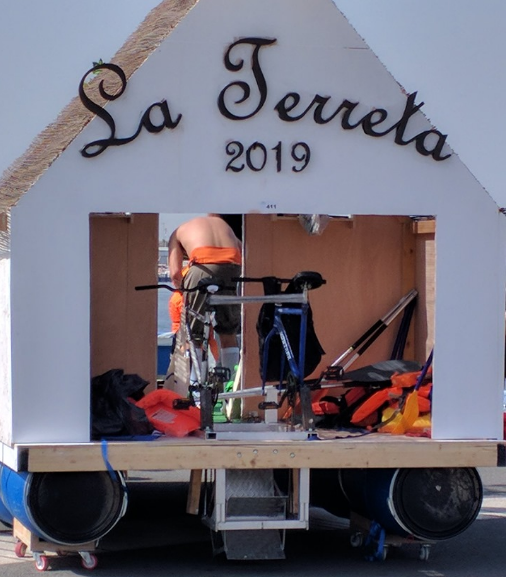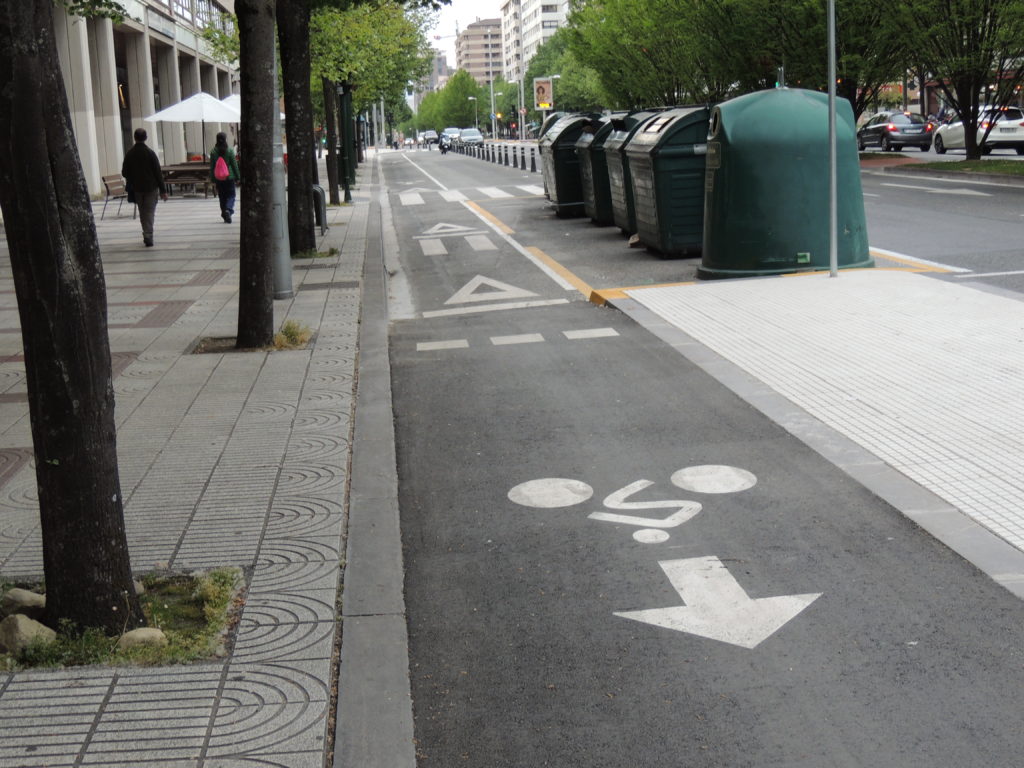Category Archives: Well done!
Sprocket man
Back in the 70’s, thousands of university students in USA rode their bicycles, without respecting the basic civility in some cases. Then, a new superhero appeared: Sprocket man. His objective was to show how to ride bikes in a respectful way regarding others actors on the streets, including pedestrians. In those years, Stanford was part of the Great American Bike Boom and their students were activists in social movements such as feminism, racial injustices or homosexual discrimination. Moreover, national problems influenced students like the Watergate or the Vietnam war. As a result, the massive cyclist movement debated on the need of biking infrastructures, and allowed publishing historical documents (Bikeway Planning in 1972, Bikeways: State of the art in 1974). Among those, there was Sprocket man.
Sprocket man was a 28-pages, colored cover and black-and-white pages, fresh magazine. Authors were inspired by the Elton John song Rocket man. As you can imagine, he used massive sprockets as a shield. He transmitted a clear message from the first page: The impressive figures of bikes in Stanford show that days in which bicycles were considered just as toys have ended. Or: The anarchy on streets can not be evaded for longer: Here you have some tips and guidelines for survival. It included advises about mechanics, how to drive, avoid thefts, accessories, etc., which persists today. The magazine was published in 1975 thanks to the support of the Stanford Public Security department. Louis H. Saekow was the cartoonist, Julia Molander coordinated it and Vince Darago headed them. Vince has been a dedicated champion of the sustainable movement for ages. He organized classes to teach riding bikes, and coordinated workshops about electric cars creation 40 years ago.
Unfortunately, Sprocket man only saw the light once. Nevertheless, it appeared again in a Seattle council TV ad, and in merchandise issues.
Coronavirus Has Changed Our Streets And We Need To Heed Those Lessons
Mad boats race
Although a bicycle could be seen like a static vehicle, one can image a myriad of ways of using it differently just by looking at it closer. A “mad boat race” is a race of DIY kind of boats by using whatever people have on hand. It does not matter whether you utilize rubber rings, airbeds, wood strips and so on. They key point here is to have a good time not only during the building process, but in the race itself. Moreover, participants dress thematically up together with their boats, so a complete combination is reached. Finally, the race takes place usually in a linear or slightly curve trajectory, or in a circuit between two or more buoys.
What does that have to do with bikes? Well, an ingenious way to provide the needed energy to move such boats is through pedaling. One or more bicycles can be implemented in a boat to win the race by easy adjusting them. Here you have an example:
Cinecicleta
Cinecicleta (kind of “bike and cinema”, in English) is a pair of bikeaholic persons who love movies. Why is so special about the Cinecicleta project carried out by Isabel Segura and Carmelo López? Well, they spent two years bringing the magic of movies to remote, small villages in Africa. At their webpage (https://cinecicleta.wordpress.com), you can see a short video to get some idea of their laudable work no matter if you do not know Spanish or French.
They rode 18,000 km (more than 11,184 miles) and made 217 screenings on white blankets in their journey. Best of all, they did so thanks to a portable cinema that carried in a bicycle trailer. Furthermore, they taught local people how to use it, how to produce electricity just by pedaling. So simple, so powerful. As a result, children faces watching a movie for the first time encouraged Isabel and Carmelo to continue with the project.
What’s more, Javier Zabala directed a documentary about their adventure in Africa that was released in April 2019. The method they followed was at least curious. The two adventurers were given three cameras in order to film the ride. As they fulled hard disks with material, they sent them to Spain. Here, Javier did the post-production work. As a result, the TCM channel was so satisfied with the documentary that decided to show it.
When journalists asked the couple what was the first thought when remembering the journey, they did not hesitate in answering: Freedom. And then explained, freedom consists in being lord of one’s time, that is precisely the drug which stimulate to ride again.
Why are we Getting Rid of a Highway in Vancouver?
The Innovative Way Ghent Removed Cars From The City
Cycling in the rain (Tilburg, NL)
Pamplona bike line
Pamplona is one of those cities in the north of Spain full of trees and vegetables thanks to the raining weather they enjoy. Pamplona is also a good place to ride. It has experienced a urban bike development in recent years, partially because of the new bike infrastructures. Here you can see one of these examples:
A bike line in an avenue is shown in the picture. It follows the exact sketch as the car lines, but additional elements are presented. Zebra crossings indicate bikers the pedestrian priority to cross the avenue, go to the trash cans or access the bus stop (the begging starts at the right of the image). Moreover, this effect is reinforced by the yield symbols. These double signals establish without any doubts who has right of way here. Furthermore, the arrow with the bike indicates the direction of travel. By the way, there is a second, one-way bike line opposite to the aforementioned one since this is a two-way avenue. Finally, beyond the trash cans, you can see an open surface which was a car line in the past. Thanks to the urban transformation, pedestrians gain space.
To sum up, intelligent bike infrastructures separate spaces for bikes, pedestrians and the rest of ways of transportation.
Seattle’s Bus Lanes
Bus only lanes in Seattle are used daily by cars because there’s no enforcement at all.
But bus riders had enough, so they decided to direct the traffic out of the bus lanes themselves
Provide flags so that other people do it
And since the politicians and the police won’t do it, the Seattle Department of Transportation decided to enforce it as well.



